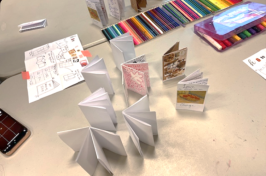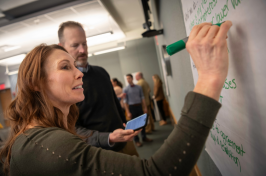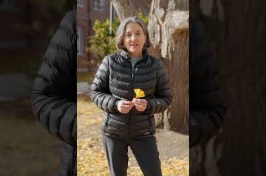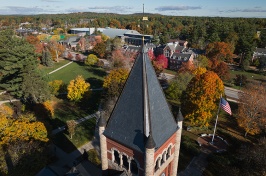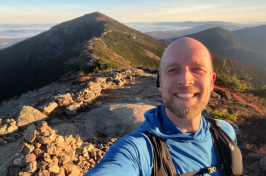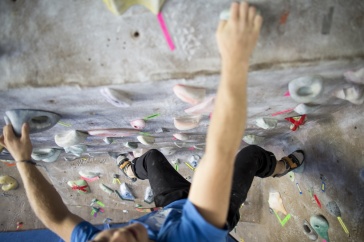
Michael Staley didn’t plan to be the first person in America to have his job, but his life experiences were preparing him for exactly that.
Staley, a doctoral candidate in sociology at UNH, has been making headlines for his work as Utah’s psychological autopsy examiner, a post in the Office of the Medical Examiner that was created by the legislature in direct response to the state’s suicide problem.
Headlines about celebrity suicides have been dominating recent news cycles, and a Centers for Disease Control study indicates suicide rates have been on the climb across the country in the past 20 years. The National Institute of Mental Health (NIMH), referencing the Centers for Disease Control and Prevention (CDC) WISQARS Leading Causes of Death Reports, which examined data from 1999 to 2016, lists suicide as the 10th leading cause of death in the United States and the second most common cause of death for individuals between the ages of 10 and 34. In the 17-year period covered by the CDC report, the suicide rate increased 28 percent.
Staley’s first-of-its-kind job is aimed at changing those statistics in Utah and could provide a blueprint for other states.

Montana to Durham to Utah
“I went to a small high school in Montana,” Staley explains, “so while you didn’t know everyone well, you did know everyone.” During the course of one year, seven of those students lost their lives: four in car accidents, three to suicide. “It was like every month — that’s what it felt like — the whole school just in mourning; teachers are crying, and students are lining up for counselors and retiring jerseys and lighting candles. I don’t think that I could talk about or write about my high school experience without talking about how those deaths impacted our school and our families.”
Parents warned their children about the importance of wearing seatbelts each time a car crash claimed another teen’s life, he recalls, but there was no explanation offered for the other deaths. Suicide was a subject no one was willing to touch. That changed during Staley’s undergraduate sociology course at Carroll College

The UNH Factor
Before Michael Staley departed for Utah, he was very involved on campus.
While pursuing his doctorate in sociology, Staley also served on the President’s Commission on the Status of LGBTQ+ People. “I was fairly recently out of the closet,” he explains. “To have the opportunity to sit on that group and hear those discussions was a powerful experience.”
Staley received a Kidder Fund Award for his research in 2011. “That was tremendously helpful financially and empowering,” Staley says, adding, “I want to keep that legacy going in any way I can.” He also served as the clerk on the Graduate Student Senate for two years and was very involved with the senate's executive leadership.
“The sociology department inspired and encouraged curiosity in ways that some of my other sociological colleagues have not experienced,” Staley says. “Without that kind of curiosity, I would never have landed where I am now. I can thank my department for preparing me technically in many ways and, more so, for allowing me to listen to the pulse in a group of people and follow it.”
“In that class, I learned about how suicide was categorized,” he explains. “It helped me understand some reasons as to why someone could be suicidal. The professor sat in front of the desk and said in some really tangible ways, ‘Here’s how you know your roommate needs help.’ It was a discussion with real-world risk applications.”
Three years after graduation, Staley decided to pursue his advanced degree in sociology. “Murray Strauss and David Finkelhor were on my radar,” he says, referring to two UNH stalwarts in sociology. “I decided I had to go to UNH,” Staley says, adding he had also discovered professor Heather Turner and her research into the sociology of AIDS. “She is still my advisor while I’m finishing my Ph.D”
Staley recalls, “That summer, moving to UNH, I decided I was going to be out and proud.” As a result, he began to learn more about risk factors for LGBTQ individuals. As he continued his graduate study, he says, he subsequently became interested in the issues LGBTQ Mormons in Utah were facing.
Staley relocated to Utah to begin working with at-risk populations while preparing his dissertation. “I came to Utah with the intention of attempting to better understand the rapid increase in the incidence rate of sexually transmitted infections among men who have sex with men,” he says, “but when I entered the field, I realized that gay, bisexual, queer and questioning Latter-day Saint (LDS) young men were coming out, dating and finding partners for casual sex in ways that I had not seen in other places, nor were these types of interactions documented in the sociological literature.” His dissertation is currently being reviewed by his committee at UNH, he explains, “but the results indicate that gay, bisexual and queer and questioning LDS young men had to come out twice: the first as a celibate-but-out gay, bisexual or queer man and then a second time, some time later, as a sexually active, romantically interested gay, bisexual or queer man.”
While working on his dissertation, Staley learned about the new post in the Office of the Medical Examiner.
“I knew I probably would not have a career studying the intersection of sexuality and religion,” he says, “but these men were at high risk, and many of them were suicidal. During my first months in Utah, I encountered individuals who were struggling with suicidal thoughts and who had made a plan. I knew this had to become my area of expertise.” And when Utah’s legislature created the psychological autopsy examiner position, Staley had to apply. "I am not assuming that the religious circumstances of LGBTQ people are driving the high suicide rate," he adds, noting there is much research to be done on the degree to which LGBTQ youth and adults are affected by suicide before quesitons of "why" can be tackled.
Science of Prevention
“This job is one of a kind. There is not another person in the country who does what I do in a state-centralized medical examiner’s office,” Staley says of his position in Utah’s Office of the Medical Examiner. “This is the kind of job you read about – it’s the kind of job your professor tells you would have been cool to have.”
Utah’s legislature created the position in response to the state’s high suicide rate with the long-term goal of gathering data to better address the issue.

Staley describes his work in two tiers: First, there’s all the data the office can possibly collect about the deceased — including educational, medical and court records — and then there’s what Staley learns in his interviews. “I go out and start speaking to usually a parent or a spouse first, someone who knew that person best, and then I try to find at least three other people who knew that person well.”
At the end of those interviews? “I’m exhausted. They’re exhausted, and then we come back with this really rich, dense information,” he says.
Staley then examines the information gathered through the data collection and interview phases. The goal is to look for trends and patterns to better inform suicide prevention efforts. “For example,” he says, “we know that adolescent males are not seeking help; we can gear prevention efforts toward that need.”
While suicide does not discriminate — anyone can be at risk — the NIMH lists several risk factors to be considered, including exposure “to others' suicidal behavior, such as that of family members, peers or celebrities.”
That is something Staley has seen firsthand.
“There are deaths we know are going to have a huge impact on their community, people who are well-known. We know that families who have had a suicide death are at risk all the more. We are learning — and we don’t understand it in a broad sense — that suicide is contagious,” Staley says. “When we introduce suicide as a method of coping with life’s stressors, other people will get that suggestion or idea, and it becomes part of the menu of options. It is such an important issue, but it is such a difficult issue to talk about correctly.”
-
Written By:
Jennifer Saunders | Communications and Public Affairs | jennifer.saunders@unh.edu | 603-862-3585

